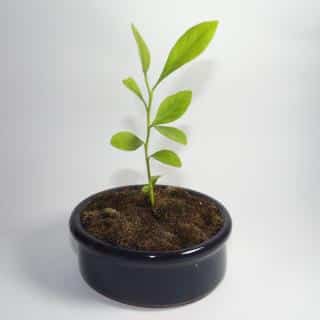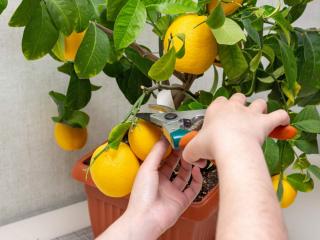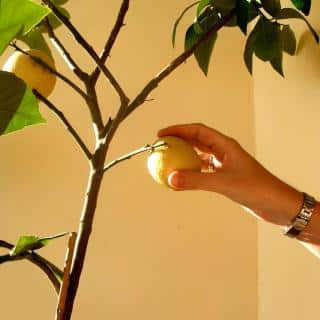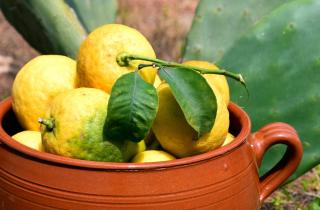

Potted lemon trees are an excellent for growing at home. Re-potting and pruning boost harvests and prevent diseases.
Key potted lemon facts
Name – Citrus limon
Height – 3 to 10 feet (1 to 3 m)
Exposure – full sun
Soil – well-drained
Foliage: evergreen – Flowering: spring/summer – Harvest: fall/winter
The climate in most of our regions isn’t well suited to growing lemon trees directly in the ground, but growing them in pots is perfectly possible.
The best varieties for growing lemon in pots are dwarf ones like the ‘Lisbon’. Special dwarf versions of the ‘Meyer’ and ‘Ponderosa’ lemons exist, too.

So the pot and soil you have put in it are their only source of food for them to stock up and grow. Re-potting is critical.
For larger pots, repotting becomes difficult. In this case, increase nutrient availability by topdressing the top of the pot with rich, fresh soil mix.
Pruning isn’t really needed but if you don’t prune your lemon tree, it will quickly grow very large.
In pots, it is best to control your tree’s growth with very regular pruning.

This will result in your lemon tree keeping a nice, tight shape.
Remove dead wood regularly and clear the inside branches of your lemon tree to let light penetrate to the center.
→ Important: many lemon trees are grafted. If you see suckers or shoots growing from below or at the graft point, prune them off immediately.
In pots, lemon trees dry up much faster than if they were planted in the ground.
In summer, frequent watering is required, whereas watering can be reduced in winter.
Every two weeks, during the growth phase, add citrus-specific fertilizer to boost fruit-bearing. You can do this while watering your lemon tree.

Lemon trees aren’t indoor plants, and can’t bear staying in a heated environment all year round. They need relatively lower temperatures from October to May.
It is important to place them in an unheated greenhouse for instance, where the temperature never drops below 32°F (0°C).

In the northern hemisphere, lemon fruits start forming in spring and slowly mature over the winter.
If ever you have to absolutely bring your lemon tree indoors to keep it from freezing, do your best to keep the air moist.
 European brown rot – lemons rot while still on the tree
European brown rot – lemons rot while still on the treeLearn more about citrus plants:
Pick the lemons as soon as they easily break off from their branch.
This shows that the fruit has matured enough for the seeds and flesh to be fully developed, without yet being over-ripe.
Hello,
I propagated a tree from seeds from a large tree at my home in CA. When I retired and moved to Iowa, I brought the tiny new tree I grew. For the last 4 years the tree has grown beautifully. I move it outside from mid Spring to November 1, when I bring it indoors for the winter. My tree has not yet produced fruit.., what are your suggestions to encourage fruit production?
Thank you!
Deanna
Your comment is awaiting moderation.
Hi my lemon tree is about 2 yrs old but it’s getting fuller at the top now in the fall I pruned it but I pruned the side branches. But it begining to get some side limbs what do I do
I have a 2 year old lemon tree in a pot and its.grown to about 4 feet. Over winter I covered it initially and then brought it into the garage but the leaves still dried up and the trunk and branches are brown. Hoping for a miracle I left.it alone and now a new shoot is growing.from the trunk at the bottom. Any advise on how to prune it and if that shoot will.grow into a viable tree eventually? Should I just chop off the trunk above that shoot? Also what care can I give it at this point to make sure it survives? Thank you!
Hi hunedr, 4 foot growth for 2 years is good! What hurts lemon trees most in winter is dry air. It’s a delicate balance to get the watering right in winter, since too much rots the plant and too little dries it out. I just wrote up an article on winterizing lemon trees, especially potted ones – hopefully it can be helpful for next year!
About your surviving shoot: first of all, to know if a branch is dead or not yet, even if brown with no leaves, there’s a simple trick: scratch the bark a bit. If it’s still green and shiny/moist underneath, then the branch is still live, don’t prune it!
The new shoot growing from the bottom is a good sign, but there’s one crucial information that’s missing at this point: is the tree grafted or not? If it’s grafted, you’ll see a joint where the bark bulges a bit, perhaps with signs of cutting and the bark is slightly different and misaligned above and below the graft point. If the trunk is smooth and continuous to the root collar (the part where roots begin), then it’s not grafted.
If your new shoot comes out from higher up above the graft point, then it’s a shoot from the grafted variety. This means it’s a known type of lemon, the one advertised on the sign. It’ll bear the fruit you expect it to. The same if your tree doesn’t seem grafted. In this case, it can grow just fine: prune the trunk off once you’re sure it’s dead, and the surviving shoot you can guide to straighten it out a bit. If the shoot has started growing already, it means it’s working to survive already. Just follow the tips in the article above to water and fertilize it well.
However, if you can see a graft point and your shoot comes out from below it, that means the new shoot is from the rootstock. It’s a citrus, but it’s almost impossible to know which one. It’s never chosen for the quality of its fruits: it’s chosen because it resists disease, grows well, etc. Whatever fruits you’ll get might not even be edible! If this is the case, then it’s really better to get a new tree altogether.
Thank you for the response Gaspard! Unfortunately it looks like the new shoot is from the rootstock since there is a distinct difference in bark and the new shoot is from below the graft point. (The scratch test showed the grafted part is dry and brown.) I will have to chalk this one to experience and try again with a new tree for next year.
I have brought a lemon tree it has one lemon and lots little lemons growing the lemon still looks a little bit green when can I pick it
Hi Deborah! Nice that you have lots of lemons coming. Normally, a lemon is ripe for picking when you twist it on its stem and it comes off before you’ve turned it over completely. If it still hangs on with one twist of your wrist, then it isn’t yet ready for picking. Lemons ripen slowly, so give it another week before trying again.
I have a 20 y/o lemon tree that has been a prolific producer for many years, however, it is large and is in dire need of repotting … needs soil. The tree is filled with blooms, blooms beginning in December. The last two years many of the blooms drop. Question: can I repot with blooms and buds and am I going to miss a lemon season?
Interesting question. Nearly all trees hate being disturbed during the blooming and fruit formation. But from what it sounds like, you’re going to miss the lemon season anyway because the flowers fall off anyways!
2 options:
1/ Repotting wihile full of flowers: you’ll loose a large part of the current blooms, almost all of them, but those that make it will certainly reach the fruiting stage thanks to the nutrients in the fresh soil.
2/ Repotting later, preferably before the next blooming season, so around October-November: if you go this route, you’ll have to topdress which is soft on the plant, and give it fertilizer in the hopes it can carry on with the fruiting that’s underway now. It’s hard to say whether this will completely solve the flower drop problem, but it’ll solve some of it. Perhaps you’ve already gone the route of fertilizing; if you’ve never fertilized, you really have an exceptional tree for having given you so many lemons of the years!
I planted a lemon seed from a variety that we liked in the grocery store. After more than a year in a small pot I moved to a much larger one. It has now grown to about 1m in height, single branch, with lots of leaves and what appears to be green thorns. Is it time for me to prune the branch or should I wait a bit longer?
Hi Kevin! Sounds like a promising specimen! Yes, you can go ahead and cut it back now; if you don’t, it’ll just keep growing taller. Lemon tends to be very apical at the beginning, meaning that the leader stem will just keep on climbing if not cut back, and there won’t be many side branches. By cutting it off at the tip, or even simply pinching the last top bud off, you’ll give it the signal to start branching out. Normally, secondary branches will start to grow from any random part of the beheaded stem. Simply keep the ones that grow the way you want them to and remove others with a quick snip while still small. For example, you might want to remove any growth that appears in the bottom 30 cm to keep it as a trunk, and then keep branches that sprout higher up.
Since you watch over the tree often, you can perform this kind of directional pruning often, too. It’s softer on the tree than the usual once-a-year massive overhaul, so simply take a good look at your tree and whenever something grows in the wrong direction, prune it out!
I would like to know how long it takes for a repotted lemon tree to give new growth after transplanting plz.
Hi Wendy, normally you should allow for a good two weeks at the very least. Even then, it may be that new buds, branches and leaves only slowly start to appear after that. It may even take up to a month to see new changes. This is because the plant is usually first focusing on repairing its root system: after repotting or transplanting, a lot of the small rootlets have broken off, and so it is a priority. Any growth above ground goes dormant in the meantime, waiting for the roots to start sending up more than the minimum “survival” sap! Note that if you do this in Fall, you’ll probably have to wait until Spring to see new growth again, unless your potted lemon is growing indoors.
My potted lemon tree has a baby, do I remove this into another pot? what soil do l use?
Hi Lyn! Wow! Did it sprout from seed? If yes, then yes, go ahead and move it to its own pot. Citrus plants love well-draining soil, it’s the most important parameter. So go for clay pebbles, vermiculite, sand/gravel, anything you can mix into the soil that helps make drainage a sure thing. Next is that if you have a choice between acidic or alkaline soil, prefer the acidic one. It’ll have an easier time blooming and bearing fruit.
If it’s an offshoot that sprouted from the side of the trunk, then it might be better to cut it off. It’s known that citrus trees often send side shoots out, these are best pruned off in order the keep the shape “tree-like”, otherwise it would grow into a dense thorny thicket.
If it’s a shoot that’s connected to a root (you have to dig delicately around it to see this), then what’s most probable is that the lemon tree is grafted: the rootstock is from a different variety. Fruits from rootstock growth tend to not be as delicious, and sometimes they’re not even the same species at all! For instance, the “swingle” rootstock is often used. If this were to bear fruit, you’d discover that they’re definitely not edible! In this case, it’s best to just cut the shoot: it’s diverting energy from the desired, grafted stock.
Lastly, if you’re sure your lemon tree isn’t grafted, and the shoot comes from the root, you can carefully dig a portion of that root out with the sapling, and transplant that to another pot.
Hope this helps!